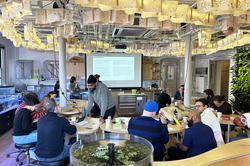Now in its fourth year, the Nature Lab program pairs EPSCoR researchers with grad students working in the fine arts.
RISD Symposium Explores Generative AI’s Effects on the Landscape of Art and Design

Experts from across the country gathered at RISD in early April for a symposium focused on artificial intelligence and its profound impact on the worlds of art and design. Organized by faculty members Marisa Mazria Katz, Daniel Lefcourt 97 PT and Marco Roso, the event brought to light the questionable ethics behind the sudden rise of generative AI technology, including its devastating environmental effects.
The conversation began in the Fleet Library, where artist and AI scholar Kate Crawford (author of Atlas of AI: Power, Politics, and the Planetary Costs of Artificial Intelligence) and Artnet News critic Ben Davis reflected on the ways that the giant corporations behind the new technology are intentionally using hype to distract us from the real issues. “These existential doomsters are the very architects of the system, which is stealing from creative laborers and using up valuable planetary resources,” Crawford explained.
She went on to describe the huge datasets that have been compiled using tagged images from corporate shopping websites, underpaid laborers working behind the scenes to make the “magic” happen, the dwindling supplies of lithium needed for computer batteries and the megaliters of fresh water required to cool these supercomputers. “It’s a gigantic post-copyright experiment happening at a global scale that is eroding the foundational pillars of intellectual property,” Crawford said.


“These existential doomsters are the very architects of the system, which is stealing from creative laborers and using up valuable planetary resources.”
The next day’s programming expanded on this discussion and included artists who use AI technology in their work, art and design educators and other experts in the field. While the consensus on AI’s future was unclear, most of the speakers agree that the system in its current form is unsustainable and benefits no one but the big venture capitalists pushing it forward.
Artist/journalist Molly Crabapple was perhaps the most vehement critic of AI, which she describes as “vampirized technology intended to disempower and impoverish artists. There is no ethical way to use these image generators powered by stolen human labor,” she added.
Crabapple joined a panel discussion with Professor Eric Telfort 05 IL, head of RISD’s Illustration department, and tech columnist/author Brian Merchant (Blood in the Machine: The Origins of the Rebellion Against Big Tech). “This is not an abstract problem,” Merchant noted. “The threat is real. Real illustrators are losing work today.” He likened the problem to emerging technologies of the past, including the Industrial Revolution and the very real resistance put up by Luddites in the early 1800s.


Telfort’s take was less decided (“I’m conflicted,” he noted). He believes that these tools can be useful to artists as long as their limitations are understood. His main concern is AI’s potential effects on future job prospects in the gaming industry.
The next panel featured MacArthur-winning artist Trevor Paglen, who blends image-making, sculpture, journalism and engineering into his work and explores the politics and assumptions built into technical systems. His talk focused on early facial recognition systems and the images of people used to train AI, largely made up of military personnel and convicts.
Co-panelist Stephanie Dinkins creates experiences that spark dialogue about race, gender, aging and emerging technologies. She builds her own extremely limited data sets to “fill in the gaps” for AI about Blackness and other human experiences. Dinkins was joined on stage by Sicilian artist Elisa Giardina Papa, whose large-scale video installations, experimental films and AI-based art projects draw attention to the “incomputable.” Papa worked as a “data cleaner” for the AI industry and discussed “the myth of universality and objectivity.”
Keynote speaker, award-winning author and activist Cory Doctorow (The Lost Cause, The Internet Con) also spoke about processes the industry uses for gathering data and the “enshittification” of online services and products. “A program that statistically infers the next word or pixel will never become self-aware,” he quipped. Doctorow spoke about effective and ineffective models for collaborating with robots and closed with this: “We need labor law, not copyright law. Collective action will work.”
“A program that statistically infers the next word or pixel will never become self-aware.”


Other afternoon speakers included experimental filmmaker Jon Rafman, acclaimed writer and Whitney Museum curator Christiane Paul, interdisciplinary artist Taeyoon Choi and multidisciplinary Filipino-American scholar Dorothy R. Santos, as well as moderators and RISD faculty members Griffin Smith and Clement Valla MFA 09 DM. Rafman showed videos investigating niche Internet subcultures that he created using early iterations of AI and expressed concern that “AI is accelerating the collapse of consensus reality.”
Paul discussed creative ways that artists like David Rokeby and Harold Cohen are using advanced technologies and maintained that “artists have been using code to tell stories for decades.” Co-panelist Choi is another good example of that, using tech to “promote a more inclusive and caring digital world.” He discussed the disconnect between materiality and computation and the human faces behind the data. Santos focuses on the audio, exploring voice recognition and other sonic tech in her practice.
The discussion moved from the importance of coding literacy to the built-in biases of current datasets to the creative potential inherent in a nuanced human-nonhuman relationship. “The answers to questions like these will shape the years ahead,” notes Provost Touba Ghadessi. “I am delighted that RISD is engaging so directly with these issues and confident that these conversations will have a lasting impact.”
Simone Solondz / top image: still from Minor Daemon (2023) by experimental filmmaker Jon Rafman
April 18, 2024


